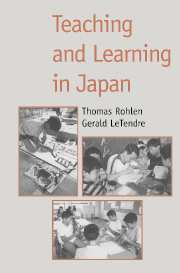Book contents
- Frontmatter
- Contents
- List of contributors
- Introduction: Japanese theories of learning
- Section I Fundamental approaches
- Section II The emotional foundations of early learning
- Section III School and classroom models
- Teachers and teaching: elementary schools in Japan and the United States
- Responsibility and learning: some preliminary hypotheses about Japanese elementary classrooms
- Cultures of mathematics instruction in Japanese and American elementary classrooms
- The Kumon approach to teaching and learning
- Section IV Path and guidance
- Section V Artistic pursuits – old and new
- Conclusion: themes in the Japanese culture of learning
- References
- Index
The Kumon approach to teaching and learning
Published online by Cambridge University Press: 05 June 2012
- Frontmatter
- Contents
- List of contributors
- Introduction: Japanese theories of learning
- Section I Fundamental approaches
- Section II The emotional foundations of early learning
- Section III School and classroom models
- Teachers and teaching: elementary schools in Japan and the United States
- Responsibility and learning: some preliminary hypotheses about Japanese elementary classrooms
- Cultures of mathematics instruction in Japanese and American elementary classrooms
- The Kumon approach to teaching and learning
- Section IV Path and guidance
- Section V Artistic pursuits – old and new
- Conclusion: themes in the Japanese culture of learning
- References
- Index
Summary
Memorization is the beginning of intelligence.
Kumon TõruIn the early summer of 1954, eight-year-old Kumon Takeshi, a second grader in Moriguchi City, Osaka, came home from school with a poor grade on his arithmetic test. His mother was concerned, but his father, Kumon Tōru, a high school math teacher, was not. “In my opinion, his health … was the most important thing during the elementary school years; I planned to put him on a structured course of study after he entered middle school” (Kumon 1981:186). But prodded by his wife, Mr. Kumon began thinking about how to help his son. He reviewed Takeshi's mathematics textbook and was surprised by the way concepts were introduced and then dropped. He turned to commercial drill books, but they only offered repetition of unimportant material. Dissatisfied with what he had found available, Mr. Kumon began crafting a home study program. He wrote out individual worksheets of minutely sequenced computation problems, adjusted to Takeshi's ability level, and assigned one each day. Happily, Takeshi's grades improved, but when they quit the regimen, his scores slipped again. The family returned to using the worksheets but found that if Takeshi skipped a few days of work, he was loath to restart the schedule. Through trial and error, a useful system eventually emerged: Takeshi did one worksheet each day under Mrs. Kumon's supervision. Mr. Kumon corrected it that night and prepared the next day's problems, gradually increasing their difficulty.
- Type
- Chapter
- Information
- Teaching and Learning in Japan , pp. 248 - 271Publisher: Cambridge University PressPrint publication year: 1996
- 2
- Cited by

